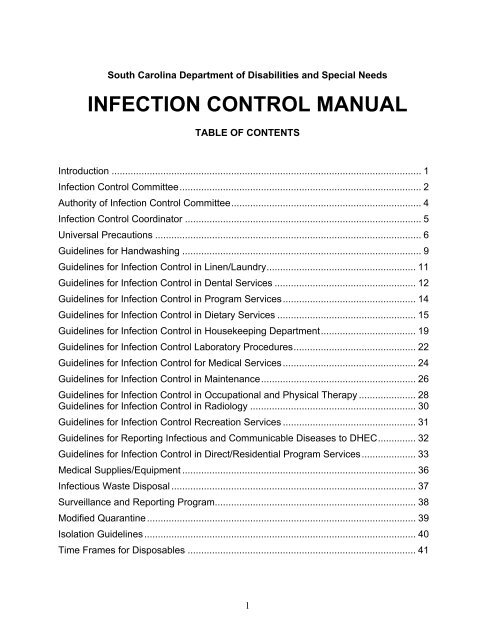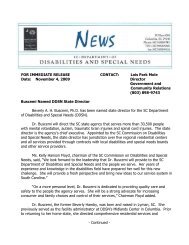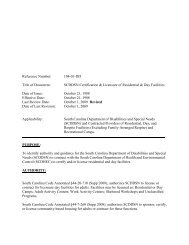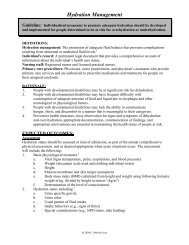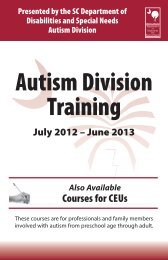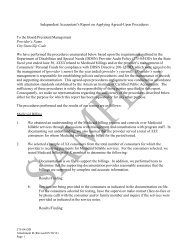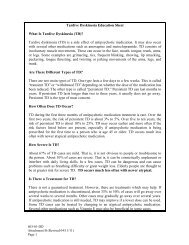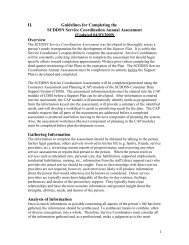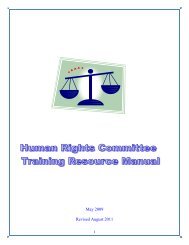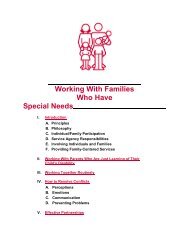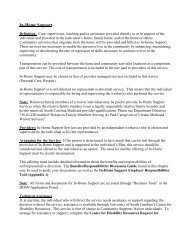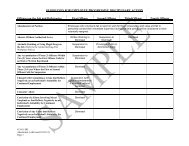infection control manual - South Carolina Department of Disabilities ...
infection control manual - South Carolina Department of Disabilities ...
infection control manual - South Carolina Department of Disabilities ...
You also want an ePaper? Increase the reach of your titles
YUMPU automatically turns print PDFs into web optimized ePapers that Google loves.
<strong>South</strong> <strong>Carolina</strong> <strong>Department</strong> <strong>of</strong> <strong>Disabilities</strong> and Special NeedsINFECTION CONTROL MANUALTABLE OF CONTENTSIntroduction .................................................................................................................. 1Infection Control Committee......................................................................................... 2Authority <strong>of</strong> Infection Control Committee...................................................................... 4Infection Control Coordinator ....................................................................................... 5Universal Precautions .................................................................................................. 6Guidelines for Handwashing ........................................................................................ 9Guidelines for Infection Control in Linen/Laundry....................................................... 11Guidelines for Infection Control in Dental Services .................................................... 12Guidelines for Infection Control in Program Services................................................. 14Guidelines for Infection Control in Dietary Services ................................................... 15Guidelines for Infection Control in Housekeeping <strong>Department</strong>................................... 19Guidelines for Infection Control Laboratory Procedures............................................. 22Guidelines for Infection Control for Medical Services................................................. 24Guidelines for Infection Control in Maintenance......................................................... 26Guidelines for Infection Control in Occupational and Physical Therapy ..................... 28Guidelines for Infection Control in Radiology ............................................................. 30Guidelines for Infection Control Recreation Services ................................................. 31Guidelines for Reporting Infectious and Communicable Diseases to DHEC.............. 32Guidelines for Infection Control in Direct/Residential Program Services.................... 33Medical Supplies/Equipment ...................................................................................... 36Infectious Waste Disposal .......................................................................................... 37Surveillance and Reporting Program.......................................................................... 38Modified Quarantine................................................................................................... 39Isolation Guidelines.................................................................................................... 40Time Frames for Disposables .................................................................................... 411
INTRODUCTIONIt is the right <strong>of</strong> every person residing in a facility for persons with disabilities andspecial needs to have a standard <strong>of</strong> living which includes an <strong>infection</strong>-<strong>control</strong>ledenvironment. It is incumbent upon each facility to provide that environment.Persons in long term care facilities <strong>of</strong>ten have a number <strong>of</strong> chronic illnesses. Inaddition, owing to their handicap, physical and mental, most persons have an alteredimmunologic response. These factors are <strong>of</strong>ten present in conjunction with poornutritional status and medical and surgical procedures that may accompany disabilitiesand special needs. As such, this population is particularly susceptible to <strong>infection</strong>.The ultimate goal <strong>of</strong> an <strong>infection</strong> <strong>control</strong> program in this facility is the protection <strong>of</strong>individuals and staff from institution-related <strong>infection</strong>s. While <strong>infection</strong> prevention effortsgenerally fall under the auspices <strong>of</strong> the <strong>infection</strong> <strong>control</strong> committee, it is theresponsibility <strong>of</strong> the administration to see that such efforts are carried out. Everyprogrammatic service within the facility must share the larger burden <strong>of</strong> the facility – tomaintain a safe environment for the people they serve.2
5. To educate the staff to the importance <strong>of</strong> reporting to responsibleauthorities when they have an <strong>infection</strong> likely to be transmitted to others.6. To review all reported communicable diseases and ensure thatappropriate cases are reported to the <strong>Department</strong> <strong>of</strong> Health andEnvironmental Control.4
AUTHORITYINFECTION CONTROL COMMITTEEBe it known that the Infection Control Committee and/or the Infection ControlCoordinator has the authority to institute appropriate <strong>control</strong> measures or initiate anystudies they feel necessary to prevent danger to personnel or individuals in certain<strong>infection</strong> cases. This has been approved by the Medical Staff and the Administration.Approved:Infection Control CoordinatorDate:Approved:Administrator, Health ProgramsDate:Approved:Medical DirectorDate:Approved:Facility AdministratorDate:5
INFECTION CONTROL COORDINATORThe Infection Control Coordinator serves as the eyes, ears, and arms <strong>of</strong> the InfectionControl Committee. Dealing with every department within the facility he/she must havefirm backing from the administration in order to do an effective job. The objectives <strong>of</strong>the coordinator are to serve as a liaison for all team members, report information onInfection Control, develop policies and procedures and see that they are implemented.This results in a high quality <strong>of</strong> individual care.At present, the Infection Control Coordinator is a Registered Nurse employed in a fulltime capacity. The Coordinator functions as surveillance <strong>of</strong>ficer for the facility.The Infection Control Coordinator is responsible for staff education, policy developmentand implementation, promotion <strong>of</strong> effective <strong>infection</strong> <strong>control</strong> and ensuring reporting <strong>of</strong>reportable diseases to DHEC.6
INFECTION CONTROL PRECAUTIONSDefinition:Purpose:An approach to <strong>infection</strong> <strong>control</strong> incorporating a combination <strong>of</strong>Universal and Standard Precautions.To minimize the risk <strong>of</strong> exposure to blood and other potentiallyinfectious body fluids <strong>of</strong> all people.Responsible Persons: All employees and volunteersI. Universal Precautions are regulations for preventing the transmission <strong>of</strong>bloodborne <strong>infection</strong>s issued by the Occupational Safety and Health Association(OSHA). They are based on the concept that all human blood and other potentiallyinfectious body fluids are treated as if they are infected with certain bloodbornepathogens. Specific <strong>control</strong> measures must be used when contact with blood orthose potentially infectious body fluids is possible.A. Body fluids to which Universal Precautions apply:1. Blood (single most important source)2. Semen and vaginal secretions (implicated in the sexual transmission <strong>of</strong>HIV and HBV)3. Cerebrospinal fluid (spinal column fluid)4. Pleural fluid (fluid around lungs)5. Synovial fluid (fluid around joints)6. Peritoneal fluid (fluid <strong>of</strong> abdominal cavity)7. Pericardial fluid (fluid around heart)8. Amniotic fluid (fluid around an unborn baby)B. Body fluids to which Universal Precautions do not apply:1. Feces, nasal secretions, sputum, saliva, sweat, tears, urine, and vomitusunless they contain visible blood.II.Standard precautions are <strong>infection</strong> <strong>control</strong> recommendations for preventing thetransmission <strong>of</strong> <strong>infection</strong>s issued by the Centers for Disease Control andPrevention (CDC). They apply to blood, all body fluids, secretions, excretions(except sweat), non-intact skin and mucous membranes.7
A. These precautions apply to every person whether existing <strong>infection</strong>s arerecognized or not.B. The CDC also recommends transmission based precautions such asairborne, contact or droplet for use with people documented or suspectedto be infected with pathogens for which additional precautions are needed.II.Protective barriers that reduce the person’s risk <strong>of</strong> exposure to blood or otherpotentially infectious body fluids are as follows.A. Gloves1. Should be worn when touching blood or other potentially infectious fluids.2. Gloves need not be worn when feeding individuals. When wiping salivafrom the skin, use protective barriers such as bibs or towels.3. General <strong>infection</strong> <strong>control</strong> practices already in existence, including the use<strong>of</strong> gloves for digital examination <strong>of</strong> mucous membranes and endotrachealsuctioning, should continue to be followed.4. Wear gloves when performing phlebotomy5. Change gloves between contact with each person and dispose <strong>of</strong> afterone use.6. Dispose <strong>of</strong> gloves out <strong>of</strong> reach <strong>of</strong> persons you care for.7. Wash hands well after removal <strong>of</strong> gloves.B. Masks, Eye Protection, Face Shields, Aprons or Gowns1. Shall be worn whenever splashes, spray, splatter, droplets, aerosols orsoiling <strong>of</strong> blood or other potentially infectious body fluids may occurIII.MISCELLANEOUS EQUIPMENTA. Sharps1. Contaminated sharps must be placed in a puncture-pro<strong>of</strong> containerlocated at site <strong>of</strong> use.2. Safety needles must be used when applicable. Needles/syringes mustnot be bent, broken, clipped or recapped. If needles must be recapped incertain situations, a one-handed scoop method must be used.8
3. When sharps containers are ¾ full, cap securely, and dispose <strong>of</strong>according to policy.B. CPR Barriers1. Mouthshields and ambu-bags should be used when available to preventthe need for emergency mouth-to-mouth contact during resuscitation.C. Personal Care Items (such as razors, bar soap, toothbrushes, hairbrushes,etc.) must be used individually and labeled with the person’s name to preventspreading <strong>of</strong> <strong>infection</strong>s and diseases.IV.Blood Spill ProcedureA. Put gloves on.B. Wipe up visible material with paper towels. Dispose <strong>of</strong> paper towels in plasticlined trashcan.C. Pour chlorine bleach (undiluted) onto spill.D. Wipe up solution with paper towels and dispose <strong>of</strong> them in plastic-linedtrashcan. Tie plastic trash bag securely and place in covered container forlater disposal at the county landfill.E. Mop area with EPA-approved disinfectant/detergent.9
Guidelines for HandwashingPurpose:To provide guidance for adherence to the Centers for Disease Controland Prevention (CDC) recommendations for handwashing and handasepsis. This has been shown to terminate outbreaks <strong>of</strong> <strong>infection</strong>s inhealth-care facilities, to reduce transmission <strong>of</strong> antimicrobial resistantorganisms and reduce overall <strong>infection</strong> rates.Guidelines:I. When to wash/clean handsA. Wash/clean hands that are visibly dirty or contaminated with blood orbody fluids with either a non-antimicrobial or antimicrobial soap andwater.B. Use an alcohol-based hand rub for routinely cleaning hands in all otherclinical situations.C. Wash/clean hands before having direct contact with persons you care for.D. Wash/clean hands before putting on gloves if you will be performing aninvasive procedure.E. Wash/clean hands after having contact with the person’ intact skin, nonintactskin, body fluids, excretions, secretions, mucous membranes orwound dressings that you are caring for.F. Wash/clean hands during care for a person if you move from acontaminated body site to a clean body site.G. Wash/clean hands after contact with contaminated objects or medicalequipment in the immediate vicinity <strong>of</strong> the person you are caring for.H. Wash/clean hands after removing glovesI. Wash hands with soap and water (either antimicrobial or nonantimicrobial)before eating and after using the restroom.J. Wash hands with either type <strong>of</strong> soap and water if exposure to Bacillusanthracis is suspected or proven. The physical action <strong>of</strong> washing andrinsing hands under these circumstances is recommended becausealcohols and other antiseptic agents have poor activity against spores.II.Hand Hygiene TechniqueA. When cleaning hands with an alcohol-based hand rub, apply the productto the palm <strong>of</strong> one hand and rub hands together, covering all surfaces <strong>of</strong>hands and fingers, until hands are dry.B. When washing hands with soap and water, wet hands first with water,apply soap to the hands, and rub vigorously for at least 15 seconds,covering all surfaces <strong>of</strong> the hands and fingers. Rinse hands with waterand dry thoroughly with a disposable towel. Use towel to turn <strong>of</strong>f thefaucet. Avoid using hot water, because repeated exposure to hot watermay increase the risk <strong>of</strong> dermatitis.10
C. Liquid, leaflet or powdered forms <strong>of</strong> plain soap are acceptable whenwashing with a non-antimicrobial soap and water.D. Do not use multiple-use cloth towels <strong>of</strong> the hanging or roll type in healthcaresettings.III.Selection <strong>of</strong> hand-hygiene agentsA. Use soaps that are as mild as possible to reduce irritation due to frequenthandwashings.B. To maximize acceptance <strong>of</strong> hand-hygiene products by Health CareWorkers (HCWs), their input should be solicited regarding the feel,fragrance and skin tolerance <strong>of</strong> any products under consideration.C. When selecting non-antimicrobial soaps, antimicrobial soaps, or alcoholbasedhand rubs, solicit information from the manufacturers regarding anyknown interactions between products used to clean hands, skin careproducts, and the types <strong>of</strong> gloves used in the facility.D. Evaluate dispenser systems <strong>of</strong> the various products used in hand hygieneto ensure that dispensers function adequately and deliver an appropriatevolume <strong>of</strong> the product.E. Never add soap to partially empty soap dispensers. This can lead tobacterial contamination <strong>of</strong> the soap.IV.Skin CareA. Encourage the use <strong>of</strong> hand creams/lotions (not petroleum based) tominimize the occurrence <strong>of</strong> irritant contact dermatitis associated with handantisepsis handwashing.B. Solicit information from manufacturers regarding any effects that handlotions, creams, or alcohol based hand antiseptics may have on thepersistent effects <strong>of</strong> antimicrobial soaps being used in the facility.V. MiscellaneousA. Keep nails trimmed and neat.B. Wear gloves when contact with blood or other potentially infectiousmaterials, mucous membranes, and non-intact skin could occur.C. Remove gloves after caring for each person. Do not wear the same pair<strong>of</strong> gloves for the care <strong>of</strong> another person. Do not wash gloves betweenuses with different persons.D. Change gloves during care <strong>of</strong> the person if moving from a contaminatedbody site to a clean body site.E. Educate all personnel regarding the types <strong>of</strong> activities that can result inhand contamination and ways to <strong>control</strong> this.F. Monitor HCWs adherence with recommended hand-hygiene practices.G. When outbreaks <strong>of</strong> <strong>infection</strong>s occur, assess the adequacy <strong>of</strong> HCW handhygiene.11
GUIDELINES FOR INFECTION CONTROL IN DENTAL SERVICESPurpose:General:To provide an effective Infection Control Program for Dental Services inaccordance with State and Federal regulations.In providing dental care, there is a possibility <strong>of</strong> transmitting <strong>infection</strong>s.The strictest <strong>of</strong> <strong>infection</strong> <strong>control</strong> practices should be followed to preventthis possibility.I. PROCEDURESA. HANDWASHING: Hands are to be washed with soap and water at the start<strong>of</strong> work, before and after patient contact (treatment), before leaving workarea, or as needed.B. GLOVES: In accordance with <strong>infection</strong> <strong>control</strong> precautions for Dentistry, theuse <strong>of</strong> gloves is mandatory when having contact with mucous membranes,blood, or saliva during dental procedures. Gloves are removed by turningthem inside out. They are disposed <strong>of</strong> after each use in an area where theycannot be retrieved by individuals.C. MASKS: Surgical masks/face shields are used during dental treatment <strong>of</strong> thepatient. They are also to be used during other procedures that may result inan airborne spray <strong>of</strong> liquid or solid particles.D. EYE PROTECTION: Safety glasses or face shields are worn duringtreatment, sterilization, and laboratory procedures. This is to prevent saliva,blood, or debris from entering a staff member’s eye.E. GOWNS: Impervious gowns are to be worn by dental personnel duringprocedures. They are disposed <strong>of</strong> after use.II.CARE OF PHYSICAL ENVIRONMENTA. Each operatory is to be cleaned after each treatment procedure with an EPAapproveddisinfectant according to the manufacturer’s instructions.B. Autoclavable instruments are placed in an ultrasonic bath – which is both anapproved presoak and cleaner – for 5 to 10 minutes. They are removed,rinsed with warm water, and dried. The instruments are then packaged andplaced in an autoclave for 20 minutes at 250 degrees F.C. The efficiency <strong>of</strong> the autoclave is assured by monthly biological testing.Results are logged in a notebook in the dental clinic. Daily tests are donewith indicator tape on packages used to wrap the instruments.D. Disposable equipment is to be used only once.E. All sterile items are checked for expiration dates and are properly disposed <strong>of</strong>as needed.F. Safety dental syringes are to be used if at all possible. If recapping <strong>of</strong> dentalsyringes is necessary, then either a mechanical device or one handed scooptechnique must be used. The needle is then placed in a sharp’s container.The container is disposed <strong>of</strong> according to procedure.13
G. Gauze, extracted teeth, tissue, and other materials saturated with blood aredisposed <strong>of</strong> in a biohazard bag or container. These items are disposed <strong>of</strong>according to procedure.H. Floors and fixtures are cleaned by housekeeping on a regular basis.I. Eating and drinking are to be done in designated areas. No food or drink isallowed in the treatment areas <strong>of</strong> the dental clinic.J. All storage areas are to be clean and dust free.III.PERSONNELA. Employees who have rashes, open wounds, colds, viral illness, etc. shouldlimit their contact with the patient until their condition has cleared.B. Other staff are required to wear masks, gloves, gowns, and eye protection iftheir assistance is needed during clinical procedures.14
GUIDELINES FOR INFECTION CONTROL IN PROGRAM SERVICESDefinition:Purpose:Developmental/Program Services is responsible for providing activetreatment in a hygienically clean and safe environment.To maintain a sanitary environment through strict observance <strong>of</strong> <strong>infection</strong><strong>control</strong> by providing a way <strong>of</strong> cleaning items that come into contact withmucous membrances or intact skin.Responsible Person:Developmental/ProgramI. Employees:A. Should maintain a high degree <strong>of</strong> personal cleanlinessB. Are to wash hands before starting to work, before and after breaks, beforeleaving work area, after bathroom breaks, and after direct contact withpeopleII.People with disabilities and special needs:A. Should maintain a high level <strong>of</strong> personal cleanlinessB. Are to wash hands before starting to work, before and after breaks, beforeand after eating and after bathroom breaksC. All people with boils and open lesions must have areas covered withdressings.D. People with elevated temperature should be evaluated as whether or notto attend programs services.III.General GuidelinesA. All equipment used in Program Services should be checked forcleanliness and proper functioning prior to use.B. Equipment and furnishings should be cleaned after each use and at theend <strong>of</strong> program day with ½ cup <strong>of</strong> chlorine bleach per gallon <strong>of</strong> water(mixed daily and labeled with dilution and date), premixed chlorinesolutions or an acceptable disinfectant.C. Disposables shall be disposed <strong>of</strong> in closed trash containers away fromwork area.D. Report unsafe, unsanitary conditions and defective equipment toimmediate supervisor.E. Report inadequacies in ventilation, lighting, temperature, plumbing, andheating/cooling to supervisor or maintenance.15
GUIDELINES FOR INFECTION CONTROL IN DIETARY SERVICESDefinition:Purpose:The Dietary <strong>Department</strong> provides food service for the residential facility.Food items vary from regular diets to therapeutic diet preparation.Food Service is an important factor within the facility contributing to clienthealth and morale. Unsanitary food service can play a significant role indisease transmission. Prevention <strong>of</strong> <strong>infection</strong> in a food servicedepartment requires healthy personnel, properly maintained equipment,uncontaminated supplies, and on-going awareness <strong>of</strong> proper sanitationand hygiene.Responsible Person:Dietary StaffI. Infection Control PracticesA. Individuals with <strong>Disabilities</strong> and Special Needs:Nursing Service notifies the dietary service when individuals are placedon <strong>infection</strong> precautions. Specific instructions will be given.B. Personal HygieneProper attire for food handlers includes an apron <strong>of</strong> impervious material, ahaircovering, freshly laundered uniform, and short clean fingernails.Facial hair is kept trimmed.Aprons must be changed when moving from a dirty area into a cleanarea.Smoking is not permitted in food preparation or serving areas.Handwashing sinks with soap dispensers and single-use towels or handdryers are provided.C. Food Products and StorageFood is stored sufficiently above floor level and away from walls. Thisfacilitates cleaning <strong>of</strong> floors and corners, and protects againstcontamination by the cleaning process itself and accidental flooding fromany source.All non-food items are properly labeled and stored away from foodproducts.16
Toxic cleaning materials are identified, stored and used in such a manneras not to contaminate food.Home-canned foods are not used.Maintain proper storage <strong>of</strong> perishable food at 45 0 F or below.Store frozen foods at or below 0 0 F.Opened food and beverage containers are to be labeled, dated, andcovered.D. Food Preparation and ServiceFood coming from broken packages or swollen cans, or food with anabnormal appearance or odor, is not served.Food is served with clean tongs, scoops, forks, spoons, spatulas or othersuitable implements so as to avoid <strong>manual</strong> contact <strong>of</strong> unpackaged food.Individual portions <strong>of</strong> food once served are not served again.Prepared food is transported to other areas in closed food carts.Unwrapped foods are protected from contamination by covers.Single-service articles are discarded after one use.E. EquipmentPlastic ware or china that has lost its glaze or is chipped or cracked isdisposed <strong>of</strong>, after being broken to prevent further use.Disposable containers and utensils are discarded after one use.Food carts are cleaned at least daily in order to remain clean andsanitary.The dishwasher maintains a final sanitizing rinse <strong>of</strong> 180 0 F and washwater <strong>of</strong> 150 0 F.F. Ice Machine1. The outside <strong>of</strong> the ice machine is cleaned daily.17
2. The inside <strong>of</strong> the ice machine is cleaned monthly and preventativemaintenance performed on a prn basis.3. Food items may not be stored directly in the ice machine.4. Cultures are performed on each ice machine prn.5. The ice scoop is kept uncovered in a clean container on top <strong>of</strong> the icemachine and is cleaned daily.G. Food Prepared or Stored Outside Dietary <strong>Department</strong>1. Food Storage on the nursing unit.a. Medicine may be stored in enclosed containers in refrigeratorscontaining foodstuffs.1) Food used for supplemental feedings, complete dietaryintake, or as medication additive, used to disguise thetaste <strong>of</strong> medicine, is considered medication.a) All open containers are dated.b) Such food is not stored for greater than 24 hours.2. Thermometers must be present in all refrigerators.3. All personal foods are dated and discarded after one week.H. HousekeepingI. All food work surfaces, utensils and equipment are cleaned andsanitized after each use. All counters are cleaned daily and asneeded with EPA-approved disinfectant.2. All floor surfaces are wet-mopped daily and as needed with EPAapproved disinfectant.3. Rodent and pest <strong>control</strong> is provided on a regular schedule and asneeded.I. Waste DisposalWaste cans with plastic garbage bags are used for all non-food waste andare to be removed daily.The removal and proper disposal <strong>of</strong> garbage from the kitchen areprovided.18
Non-food garbage is removed daily. Trash cans are cleaned andsanitized.II.Controls on the SystemAll preventative and corrective maintenance is documented.Environmental cultures are done as necessary. A foodborne outbreak, orsuspicion <strong>of</strong> such, is grounds for cultures <strong>of</strong> possible sources. Results are tobe reviewed by the Infection Control Committee.Periodic prevalence walks are conducted by the Food Service Director.Records <strong>of</strong> proper temperature for refrigeration and freezing equipment arekept in Food Service.19
GUIDELINES FOR INFECTION CONTROL IN THE HOUSEKEEPING DEPARTMENTDefinition:Purpose:The Housekeeping <strong>Department</strong> is responsible for providing safe,comfortable, clean, and attractive living surroundings.To maintain sanitary environment in the facility through strict observance<strong>of</strong> established housekeeping and custodial policies and procedures, asrequired by state and local codes.Responsible Person:Housekeeping staffI. General InformationA. Select detergents/sanitizers for cleaning, sanitizing and disinfecting allareas.B. Housekeeping personnel are to prepare disinfectant solutions according tomanufacturer’s instructions in housekeeping procedure.1. Underdilution results in ineffective kill <strong>of</strong> organisms.2. Overdilution may result in safety hazard.C. Always use utility gloves for housekeeping procedures – not medical examglovesD. Rodent and pest <strong>control</strong> is on a routine schedule and as needed.II.Cleaning GuidelinesA. Clean from least-contaminated to most-contaminated areas.1. Clean from top to bottom.2. Remove loose dirt/debris before washing or mopping.B. Change cleaning cloths, mop heads and solutions according to policy.C. After use, rinse mop buckets and store dry.D. Avoid cleaning methods that generate dust aerosols.1. Remove dirt and debris with treated dry mop.2. Straw brooms are not to be used to sweep floors. Only use strawbrooms when sweeping outside.20
E. Reduce potential contamination from cleaning toilet fixtures.1. Personnel are to wear gloves during procedure.2. Wash hands after cleaning each area.3. Clean reusable toilet mops frequently, store dry between uses.F. Special Cleaning Activities1. When isolation precautions are used, follow isolation instructions2. Change curtains when soiled.3. Clean and damp dust vents and blinds when dusty.4. Spot wash walls as necessary.5. Clean light fixtures as necessary.G. Terminal Cleaning1. Use same procedure as daily cleaning.2. All disposable items must be placed in a plastic bag and be disposed<strong>of</strong> as trash.3. Reusable items shall be removed by nursing service personnel andcleaned and disinfected according to procedure.4. It is not necessary to discard toilet paper or paper towels following aperson’s discharge.H. Wastebaskets or other receptacles should be lined with sturdy plastic bags.1. Close bags securely and remove when ¾ full.2. Transport bags to dumpster at least daily.I. Blood/Bloody Body Fluids Clean-Up1. Always use gloves; use other barrier precautions (masks, gowns,goggles, etc.) as needed.2. Using paper towels, mop up gross blood. Dispose <strong>of</strong> gloves andpaper towels in plastic lined trashcan.21
3. Pour undiluted bleach on blood/bloody body fluids (do not splash!); letsit 5 minutes.4. With new gloves on, wipe up bleach with paper towels and dispose <strong>of</strong>gloves and towels in plastic lined trashcan.5. Mop area with an EPA approved detergent.6. Rinse bucket and let dry22
GUIDELINES FOR INFECTION CONTROL FOR LABORATORY PROCEDURESDefinition:Purpose:The laboratory procedures are performed to provide diagnostic andtherapeutic results.The clinical laboratory provides diagnostic testing, consultation,interpretation <strong>of</strong> results, and resource material for the appropriatecollection and transport <strong>of</strong> specimens. Infection <strong>control</strong> practices shall beobserved to prevent the spread <strong>of</strong> <strong>infection</strong>s.Responsible Person:Laboratory Technologist/Nursing StaffI. Precautionary MeasuresA. To prevent parenteral, mucous membrane, and non-intact skin exposurefrom pathogens in body fluids:1. Gloves are provided for handling body fluid specimens. Mask andprotective eyewear are required when the worker’s mucousmembranes may come into contact with body fluids.2. Gloves shall be provided to the phlebotomist.B. To protect the laboratory technologist’s clothing, a closed lab coat is worn inthe laboratory.C. Handwashing must be performed before and after blood drawing orhandling body fluids.D. To maintain an aseptic environment:1. Floors and counters are cleaned daily using an EPA-approveddisinfectant detergent.2. The refrigerator interior and exterior surfaces are cleaned as needed.3. Spills <strong>of</strong> blood are wiped up with full strength chlorine bleach.E. To dispose <strong>of</strong> contaminated materials.1. Put the entire needle/syringe into a “puncture pro<strong>of</strong> needle disposalcontainer” at site <strong>of</strong> use. When ¾ full transfer unit for pick-up bybiohazard disposal contract company.23
2. If a vehicle is used, all biohazard wastes including sharps containersmust be transported between sites in the trunk <strong>of</strong> a car or the back <strong>of</strong>a truck.3. Liquid waste is flushed down the sink.4. Culture slides, blood tubes, urine and stool cups are disposed <strong>of</strong> in abiohazard puncture pro<strong>of</strong> container.5. Biohazard containers are stored in a locked area.6. Biohazard waste is transported to be incinerated according to Stateregulations.II.Collection and Transporting Of Lab SpecimensA. Collection <strong>of</strong> Blood1. Use appropriate barrier techniques.2. Use aseptic technique and disposable equipment.3. Use sterile equipment.B. Transporting Specimens1. Use containers with secure closures.2. Flag specimens at collection site with biohazard symbol.24
GUIDELINES FOR INFECTION CONTROL FOR MEDICAL SERVICESDefinition:Purpose:Medical Services are responsible for prevention <strong>of</strong> <strong>infection</strong>s.To insure optimum protection through strict adherence to established<strong>infection</strong> <strong>control</strong> and safety policies and procedures.Responsible Person:Medical Services PersonnelI. General GuidelinesA. Employees:1. Should maintain a high degree <strong>of</strong> personal cleanliness.2. Staff should wash hands after performing tasks involving directcontact with body fluids.3. Gloves or other appropriate barrier precautions should be used whencontact with blood or other potentially infectious body fluids areanticipated.B. Equipment1. All disposable contaminated equipment items must be disposed <strong>of</strong>according to infectious waste procedure.2. All contaminated sharps are to be disposed <strong>of</strong> in sharps containeraccording to procedure.3. All contaminated, non-disposable equipment is to be cleaned anddisinfected according to procedure.4. Refrigerators in medical areas:a. Will be cleaned and defrosted as needed.b. Will contain a thermometer to assure the temperature is in thesafe zone.c. All opened containers will be dated, labeled, covered, anddisposed <strong>of</strong> according to policy.d. All refrigerated medications must be kept in a closed containerfor medicines only.25
5. Medicine CartsC. Linena. Will be cleaned each day.b. Will have waterless hand disinfectant available for use whensoap and water are unavailable after giving medicines.1. Clean linen is to be kept in a closed area or covered when not inuse.2. All soiled linen will be placed in a covered laundry hamperimmediately after use.26
GUIDELINES FOR INFECTION CONTROL IN MAINTENANCEDefinition:Purpose:The Maintenance <strong>Department</strong> provides a hygienically clean environmentby systematic inspection and preventative maintenance <strong>of</strong> all equipment.To ensure that the facility is structurally and environmentally safe andsanitary by adhering to established policies and procedures andmaintaining compliance with standards established by federal, state, andlocal regulatory agencies.Responsible Person:Maintenance StaffI. Infection Control PracticesA. Equipment1. Water Supplya. Facility water supply systems are not connected with other pipingsystems or with fixtures that may allow contamination.b. Water supplies are protected from contamination by theinstallation <strong>of</strong> vacuum breakers.2. Plumbing Fixturesa. Aerators are not installed on faucets.B. Maintenance <strong>of</strong> Buildings1. All surfaces (floors, walls and ceilings) are constantly inspected andrepaired when necessary in order to maintain smooth, dry andcleanable surfaces.2. Any openings or breaks in the walls, foundations, window frames, etc.,are repaired in order to preserve a clean environment.3. Employees shall report all unsanitary, unsafe environmental orworking conditions to the supervisor.4. Rodent and pest <strong>control</strong> is on a routine schedule and as needed ifapplicable to this department.C. Personnel1. Dress Code27
a. Clothing and shoes are changed when they becomecontaminated.b. Heavy boots and coveralls and/or gloves are worn whenmaintenance personnel are exposed to gross contaminatedwastes (dumpsters, broken sewage lines and so on).c. Maintenance personnel follow the dress code for specific areaswhen applicable.D. Ventilation System1. Inlet and outlet openings are protected by a grill or screen andcleaned as needed.2. Air filters on air conditioning units.a. Filters are cleaned and replaced as necessary.b. Disposable filters are never cleaned and reused.28
GUIDELINES FOR INFECTION CONTROL INOCCUPATIONAL THERAPY AND PHYSICAL THERAPYDefinition:Purpose:The role <strong>of</strong> occupational/physical therapy is to prevent crosscontaminationand <strong>infection</strong>s.To ensure optimum protection <strong>of</strong> people in the administration <strong>of</strong>occupational therapy and physical therapy through strict adherence toestablished <strong>infection</strong> <strong>control</strong> and safety policies and procedures.Responsible Person:Occupational Therapy and Physical Therapy PersonnelI. General GuidelinesA. Employees1. Should observe <strong>infection</strong> <strong>control</strong> precautions at all times2. Should maintain a high degree <strong>of</strong> personal cleanliness.3. Staff should wash hands before and after assisting with tasksinvolving direct contact. Wash hands with a liquid soap using properhand washing techniques.4. Gloves should be worn when coming in contact with any blood,potentially infectious body fluids, or open wounds. Gloves will beremoved and discarded immediately after contact.5. Gloves should be worn during digital exam or stimulation or the oralcavity.B. Equipment1. All equipment should be cleaned after each use with an antisepticsolution following the manufacture’s recommendation.2. Adaptive Equipmenta. All adaptive equipment will be labeled with the person’s name andused individually.b. All adaptive feeding equipment will be sanitized after washing anddried. They may then be stored in a clean, dry environment.c. All adaptive toothbrushes will be rinsed after each use, and airdriedbefore storage.29
C. Linen1. If using linen to cover positioning equipment, change linen after useon each person.2. Clean linen will be kept covered or in enclosed cabinets.3. All soiled linen will be placed in a covered laundry hamperimmediately after each use.30
GUIDELINES FOR INFECTION CONTROL INRADIOLOGYDefinition:Purpose:The Radiology <strong>Department</strong> provides diagnostic and therapeuticprocedures.The Radiology <strong>Department</strong> performs diagnostic procedures which requireradiology personnel to have direct contact with people and occasionallywith their blood and body secretions during radiological procedures.Proper techniques shall be observed in order to prevent the spread <strong>of</strong><strong>infection</strong>.Responsible Person:Radiology PersonnelI. Infection Control PracticesA. Follow <strong>infection</strong> <strong>control</strong> precautions at all times.B. Non-contrast studies, such as plain film radiology.1. Have individuals with an illness spread by the airborne route wear amask while in the department.2. Wash hands before and after contact.3. Use sterile gloves and dressings for open wounds.C. Follow the physician’s orders while maintaining aseptic technique duringcontrast-media studies.D. Cleaning X-ray Equipment1. Radiology equipment shall be cleaned after each use with an EPAapproveddisinfectant.2. A thorough cleaning <strong>of</strong> all x-ray equipment and surfaces shall beperformed monthly.31
GUIDELINES FOR INFECTION CONTROL FOR RECREATION SERVICESDefinition:Purpose:To prevent cross-contamination <strong>of</strong> <strong>infection</strong> in recreation services.To maintain a sanitary environment in recreation services through strictobservance <strong>of</strong> established <strong>infection</strong> <strong>control</strong> and safety policies andprocedures.Responsible Person:All Recreation StaffI. General GuidelinesA. Employees1. Observe <strong>infection</strong> <strong>control</strong> precautions at all times2. Maintain a high degree <strong>of</strong> personal cleanliness.3. Staff should wash hands before and after tasks involving directcontact. Wash hands with a liquid soap using proper hand washingtechniques.B. Equipment1. Pool – follow DHEC regulations for proper use and care2. All other equipment will be cleaned and disinfected after each use andas needed.32
GUIDELINES FOR REPORTING INFECTIOUS ANDCOMMUNICABLE DISEASES TO DHECDefinition:Purpose:The <strong>of</strong>ficial reporting <strong>of</strong> certain infectious and communicable diseases to<strong>Department</strong> <strong>of</strong> Health and Environmental Control (DHEC) in accordancewith their yearly published list.To provide information to the <strong>Department</strong> <strong>of</strong> Health and EnvironmentalControl concerning certain infectious and communicable diseases forstatistical, informational, and consultative purposes as well as for use indisease prevention.Responsible Person:Infection Control CoordinatorI. General GuidelinesA. List <strong>of</strong> reportable diseases1. Official yearly reportable disease list will be obtained from DHECannually by the Infection Control Coordinator.2. The list will be duplicated to all physicians, nursing supervisors, andnurses’ stations for posting.B. In case <strong>of</strong> reportable disease1. The Infection Control Coordinator will be notified <strong>of</strong> the reportabledisease by the nursing staff and/or physician in charge.2. The Infection Control Coordinator will obtain the necessaryinformation to complete the DHEC Reportable Disease Card andnotify either by phone or mail the appropriate county healthdepartment according to the instructions on the <strong>of</strong>ficial list.3. The Infection Control Coordinator will document the above actions.4. This information will be shared with the appropriate person.33
GUIDELINES FOR INFECTION CONTROL INDIRECT/RESIDENTIAL PROGRAM SERVICESDefinition:Purpose:Direct/Residential Program Services is responsible for preventing crosscontamination<strong>of</strong> <strong>infection</strong>s while providing active treatment in a clean andsafe environment.To ensure optimum protection in the administration <strong>of</strong> activities <strong>of</strong>programs and daily living through strict adherence to established <strong>infection</strong><strong>control</strong> and safety policies and procedures.Responsible Person:Direct/Residential Program Services PersonnelI. General GuidelinesA. Employees1. Employees should maintain a high degree <strong>of</strong> personal cleanliness.2. Staff should wash hands and/or use hand-wipes when assisting intasks involving direct contact.3. Wash hands with a liquid soap using proper hand washing techniques.Wash hands before starting work, before/after breaks and afterbathroom breaks.4. Gloves should be worn when coming in contact with any blood,potentially infectious body fluids or open wounds. Gloves will beremoved and discarded immediately after contact. Wash hands well.5. Direct/Residential Program Services personnel will receive periodic inserviceinstruction regarding <strong>infection</strong> <strong>control</strong> and preventing <strong>of</strong> crosscontamination.6. Observe <strong>infection</strong> <strong>control</strong> precautions at all times.7. Staff should report any signs or symptoms <strong>of</strong> illness observed duringcare to the unit nurse.B. People with <strong>Disabilities</strong>1. Personal care items (combs, brushes, toothbrushes, razors, etc.)a. Keep clean and in good condition.b. Label with each person’s name and use individually.c. Store appropriately.2. MealtimeEmployees must:34
a. Wash and dry hands before mealsb. Use waterless disinfectant as needed during meal time.c. Wash hands and faces before and after meals.d. Provide hand towels and soape. Clean and disinfect feeding area after mealsC. Cleanliness <strong>of</strong> Equipment1. Wheelchairs should be cleaned after each meal, toileting accidents,and as needed.2. Bathing facilities should be cleaned after each use.3. Bedpans and urinals should be labeled with name (not shared),stored, and covered accordingly.D. Linen and Clothing1. Towels, washcloths and clothing must not be shared2. Dirty Linen/Clothinga. Should not be placed on floor.b. Must be transported to dirty linen area in a covered container.c. Linen/clothing should be sorted and placed in covered containersfor storage.3. Clean Linen/Clothinga. Clean linen is to be kept in a closed area or covered when not inuse.b. Linen should not be stockpiled in work areas.3. When transporting clean linen, it should be covered.E. Activity materialsA. All activity materials should be checked for cleanliness and properfunctioning prior to use.B. Activity materials and furnishings should be cleaned after each usewith a disinfectant.C. Disposables should be discarded in closed trash containers.D. Report unsafe, unsanitary conditions and defective equipment toimmediate supervisor.E. Report inadequacies in ventilation, lighting, temperature, plumbingand heating/cooling to supervisor or maintenance.35
F. Waste Disposal1. All soiled adult briefs are placed in a covered container, lined with aplastic trash bag.2. All bagged trash should be disposed <strong>of</strong> in outside receptacles daily ormore frequently, as needed.3. All peri-pads or disposable diapers containing blood are bagged priorto placing them in a plastic trashcan.36
MEDICAL SUPPLIES/EQUIPMENTA. Most medical supplies are disposable, used one time only and discarded.B. The following precautions are observed in the collection <strong>of</strong> reusable items:1. All supplies and equipment used in medical procedures are consideredpotentially infectious and handled accordingly.2. Used equipment is cleaned with soap and water prior to dis<strong>infection</strong>according to manufacturer’s instructions.37
INFECTIOUS WASTE DISPOSALDefinition:Purpose:The safe disposition <strong>of</strong> infectious waste.To prevent the spread <strong>of</strong> diseases through safe disposal <strong>of</strong> infectiouswaste.Responsible Person:All StaffI. General GuidelinesA. All soiled dressings or blood contaminated items are to be placed in acovered, plastic-lined trashcan or bagged and placed in open plastic-linedtrashcan.B. All soiled diapers and peri-pads are to be wrapped or bagged prior to placingin a plastic-lined trashcan or covered container.C. All blood and body excreta shall be flushed into the sewer system.D. All bagged trash is disposed <strong>of</strong> in the dumpster daily or more frequently ifnecessary.II.Contaminated MaterialA. All sharps (such as needles, scalpel blades, razor blades, ampules andother disposable sharps) shall be placed in impervious plastic containersdesignated for this purpose for collection and disposal and incineration bycontact agency.B. All super saturated items (dripping blood) are to be placed in a redbiohazard bag to be collected for disposal and incineration by contractagency.38
SURVEILLANCE AND REPORTING PROGRAMPURPOSE:To detect and record <strong>infection</strong>s in a systematic fashion. This in turn enables themost effective and practical <strong>control</strong> procedures to be utilized.TECHNIQUES USED:1. Review all culture reports and follow up if needed2. Consultations with all service areas as necessary3. Prevalence study done as needed4. Telephone reports as necessary5. The Infection Control Coordinator reports to DHEC as necessary39
MODIFIED QUARANTINEDefinition:Purpose:A selective, partial limitation <strong>of</strong> daily activities <strong>of</strong> persons who are knownor presumed to have been exposed to certain communicable diseasesand have the potential for transmitting it to others.To prevent the transmission or outbreak <strong>of</strong> certain communicablediseases.Responsible Person:Physicians and NursesActivities:1. All persons in the building under modified quarantine will be excluded fromprogramming, school or work for a period <strong>of</strong> time no longer than the longestincubation period <strong>of</strong> the disease, with the count beginning from the lastreported active case.2. No outside activities or visits from persons other than the necessaryworkers in the building will be allowed until the incubation period haslapsed.3. Good handwashing techniques must be observed with hands washedbetween contact with each person. Wash hands before leaving thebuilding.4. The physician and the <strong>infection</strong> <strong>control</strong> coordinator will determine by thetype <strong>of</strong> communicable disease if any special precautions, as in laundry,dietary or housekeeping are necessary.40
ISOLATION GUIDELINESFollow the CDC Guidelines41
TIME FRAMES FOR DISPOSABLESSingle Use devices.......................................................(ex: suture sets)Feeding syringes..........................................................(nasogastric & gastrostomy)Humidifiers used with 02 ..............................................Nasal cannulas, masks & 02 tubing .............................use once and dispose <strong>of</strong>Clean & air dry after each use; label w/date &name; change every 3 daysIf disposable change q 7 days.If reusable, empty, disinfect & refill w/sterileH2O q 24 hrs.For individual use only; dispose <strong>of</strong> PRN or atD/CNebulizers on IPPBs & mist machines .........................Tubings & masks on mist machines.............................Irrigation Fluids.............................................................Multi-dose medication vials ..........................................Nasogastric tubes ........................................................Tube feeding sets.........................................................Opened feedings, juices etc. in refrigerator..................IV Cannulas..................................................................IV Fluids .......................................................................IV Tubings....................................................................Urinary Catheters .........................................................Suction Catheters.........................................................Suction Bottles .............................................................Suction Tubings ...........................................................Dispose <strong>of</strong> single –use handheld Nebulizerkits after 24 hr. (1 kit/person/day)For re-usables, after each use empty liquid,disinfect & refill w/sterile distilled H2OChange every 24 hoursDate & discard 24 hours after OpeningDate when opened & discard on expirationdate or at the manufacturer’srecommendation in the package insertChange as ordered or PRNEvery 24 hrs.Date & discard every 24 hr.Every 72 hr. or as orderedEvery 24 hrs.Every 48 hrs.PRNFlush w/sterile H2O & dispose <strong>of</strong> after eachuseIf disposable, empty and rinse q 8hrs. &dispose <strong>of</strong> @ D/C or PRN. If reusable, emptyq 8hrs. & disinfect after D/CDispose <strong>of</strong> after D/C or PRN42


